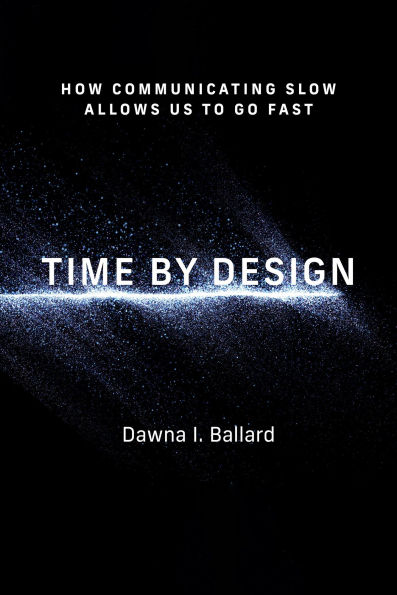How effective individuals, teams, and organizations routinely communicate slow to go fast, and how time as a feature of human experience can actually be designed.
Speed in collective action, like teamwork or organizing, is never simply a time-based issue. While conventional theory relies on time-based interventions to achieve speed, this approach typically fails. In Time by Design, Dawna Ballard shows how speed is actually a function of the relationship between time and communication, or chronemics.
Ballard identifies two communication design logics—fast and slow—that reflect contrasting beliefs about how communication works to support urgent, time-sensitive work demands. Fast communication design logics are linear, short term in orientation, and treat time in interaction as transactional. Slow communication design logics are nonlinear and long term in orientation and treat time in interaction as transcendent. Given these distinct approaches, the book offers a practical toolkit that shows the reader how the two chronemic designs can be used in complementary fashion—and how effective teams, communities, and organizations routinely communicate slow to go fast.
1147147636
Speed in collective action, like teamwork or organizing, is never simply a time-based issue. While conventional theory relies on time-based interventions to achieve speed, this approach typically fails. In Time by Design, Dawna Ballard shows how speed is actually a function of the relationship between time and communication, or chronemics.
Ballard identifies two communication design logics—fast and slow—that reflect contrasting beliefs about how communication works to support urgent, time-sensitive work demands. Fast communication design logics are linear, short term in orientation, and treat time in interaction as transactional. Slow communication design logics are nonlinear and long term in orientation and treat time in interaction as transcendent. Given these distinct approaches, the book offers a practical toolkit that shows the reader how the two chronemic designs can be used in complementary fashion—and how effective teams, communities, and organizations routinely communicate slow to go fast.
Time by Design: How Communicating Slow Allows Us to Go Fast
How effective individuals, teams, and organizations routinely communicate slow to go fast, and how time as a feature of human experience can actually be designed.
Speed in collective action, like teamwork or organizing, is never simply a time-based issue. While conventional theory relies on time-based interventions to achieve speed, this approach typically fails. In Time by Design, Dawna Ballard shows how speed is actually a function of the relationship between time and communication, or chronemics.
Ballard identifies two communication design logics—fast and slow—that reflect contrasting beliefs about how communication works to support urgent, time-sensitive work demands. Fast communication design logics are linear, short term in orientation, and treat time in interaction as transactional. Slow communication design logics are nonlinear and long term in orientation and treat time in interaction as transcendent. Given these distinct approaches, the book offers a practical toolkit that shows the reader how the two chronemic designs can be used in complementary fashion—and how effective teams, communities, and organizations routinely communicate slow to go fast.
Speed in collective action, like teamwork or organizing, is never simply a time-based issue. While conventional theory relies on time-based interventions to achieve speed, this approach typically fails. In Time by Design, Dawna Ballard shows how speed is actually a function of the relationship between time and communication, or chronemics.
Ballard identifies two communication design logics—fast and slow—that reflect contrasting beliefs about how communication works to support urgent, time-sensitive work demands. Fast communication design logics are linear, short term in orientation, and treat time in interaction as transactional. Slow communication design logics are nonlinear and long term in orientation and treat time in interaction as transcendent. Given these distinct approaches, the book offers a practical toolkit that shows the reader how the two chronemic designs can be used in complementary fashion—and how effective teams, communities, and organizations routinely communicate slow to go fast.
28.99
Pre Order
5
1

Time by Design: How Communicating Slow Allows Us to Go Fast
234
Time by Design: How Communicating Slow Allows Us to Go Fast
234Related collections and offers
28.99
Pre Order

Product Details
| ISBN-13: | 9780262383554 |
|---|---|
| Publisher: | MIT Press |
| Publication date: | 12/16/2025 |
| Series: | Design Thinking, Design Theory |
| Sold by: | Penguin Random House Publisher Services |
| Format: | eBook |
| Pages: | 234 |
| File size: | 20 MB |
| Note: | This product may take a few minutes to download. |
About the Author
From the B&N Reads Blog
